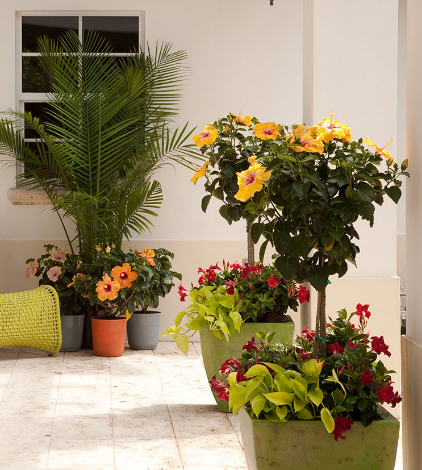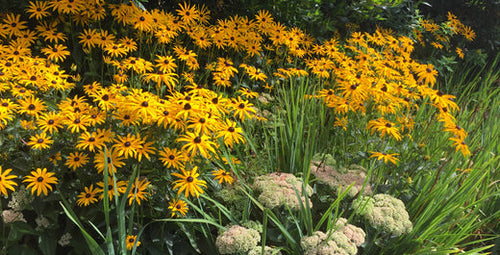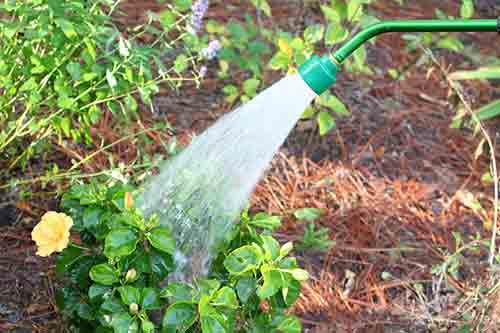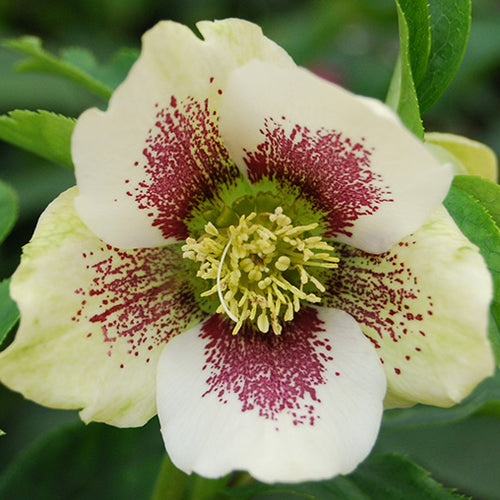By Karen Weir-Jimerson
Shade gardeners rejoice! Hostas are the saviors of dark spots in your yard and garden. These leafy beauties rise in early spring and unfurl their leaves to create mounds of foliage that transform shaded, bare space into a verdant oasis. Hostas do best in dappled shade and grow well under large trees where other plants can’t. Some varieties tolerate some sun (usually the less intense morning light), but if exposed to too much light, most hostas will experience leaf burn. Check the plant tag for the light requirements of each variety.
Hostas are perennials, which means they will come back bigger and better every year. Most hostas grow well in Zones 3 to 9. These versatile shade plants form a mound of leaves but vary greatly by variety, offering differences in plant size, leaf shape, and leaf color. While hostas are known best for their leafy charms, in midsummer, they also send up long stems that are topped with pendulous white or lavender flowers. Some blooms are sweetly fragrant, making them ideal for cutting for bouquets. Hosta plantaginea features white flowers that are scented.
Hosta leaves range in size, shape, and texture. Larger hosta varieties bear large leaves while smaller varieties, such as the aptly named ‘Lucky Mouse Ears’, have small foliage. Leaf shapes vary, too. Some hostas feature almond-shape, almost strappy leaves. Others bear rounded leaves in a slight heart shape. Hostas range in leaf texture as well, from smooth to corrugated. Flat, smooth-leaf hostas look beautiful paired with those with puckered leaves.
2. Divide hostas in the spring and fall. The cooler temperatures in these seasons make it easier for the plant to set down roots and grow.
3. Slugs like hostas. If your garden is prone to slug damage, choose hostas with thicker, more puckered leaves. Slugs have a harder time with the textural terrain of these hostas.
Shade gardeners rejoice! Hostas are the saviors of dark spots in your yard and garden. These leafy beauties rise in early spring and unfurl their leaves to create mounds of foliage that transform shaded, bare space into a verdant oasis. Hostas do best in dappled shade and grow well under large trees where other plants can’t. Some varieties tolerate some sun (usually the less intense morning light), but if exposed to too much light, most hostas will experience leaf burn. Check the plant tag for the light requirements of each variety.
 Types of Hostas
Types of Hostas
Hostas are perennials, which means they will come back bigger and better every year. Most hostas grow well in Zones 3 to 9. These versatile shade plants form a mound of leaves but vary greatly by variety, offering differences in plant size, leaf shape, and leaf color. While hostas are known best for their leafy charms, in midsummer, they also send up long stems that are topped with pendulous white or lavender flowers. Some blooms are sweetly fragrant, making them ideal for cutting for bouquets. Hosta plantaginea features white flowers that are scented.Small Hostas
These tiny delights are ideal for small gardens, edging a pathway, or in containers. These tiny hostas grow from 2 to 12 inches tall. Types to try include ‘Pandora’s Box’, ‘Lucky Mouse Ears’, and ‘Tokudama Flavocircinalis’.Midsize Hostas
Ideal for middle of the border or as an edging plant, midsize hostas grow 1 to 3 feet tall. These mounding beauties are available in a wide selection of leaf types, including green and white ’Blazing Saddles, dusty blue ’Bressingham Blue’, and apple-green ‘Guacamole’.Big Hostas
Some hostas can grow to the size of shrubs. These beauties rise tall (‘Krossa Regal’ grows up to 3 feet tall and produces flower stalks that rise to 5 feet) and some spread wide (for example ‘Frances Williams’ grows 18 inches tall but spreads out to 4 feet). Hosta of the Year in 2004, ‘Sum and Substance’ grows 2 feet tall and 60 inches wide.Lots of Colors
Although mostly green and leafy, hostas come in a surprising range of colors in the green spectrum, from yellow green to chartreuse, to dark green to blue-green. Leaves can be splashed with white, cream or yellow, which is called variegation. Hosta variegation may create narrow stripes of white, cream, or yellow, or larger splashes of color. Breeders introduce new and interesting hosta varieties every year. Leaf Diversity
Leaf Diversity
Hosta leaves range in size, shape, and texture. Larger hosta varieties bear large leaves while smaller varieties, such as the aptly named ‘Lucky Mouse Ears’, have small foliage. Leaf shapes vary, too. Some hostas feature almond-shape, almost strappy leaves. Others bear rounded leaves in a slight heart shape. Hostas range in leaf texture as well, from smooth to corrugated. Flat, smooth-leaf hostas look beautiful paired with those with puckered leaves. Picking Plants
When shopping for hostas, look for plants that have lush foliage. Plants shouldn’t have yellow or dead leaves. The leaves should be free of holes or discoloration. When choosing varieties, look at the plant tag to see the mature height and width. Keep in mind, that young hostas, whether short or tall varieties, look similar on the nursery shelf. It may take a season or two for them to reach their ultimate size.Keeping Hostas Healthy
1. Hostas prefer soil that is moist, yet well drained. They don’t like overly wet spots, sandy, or clay-like soil. To improve the drainage of the soil, mix sand in the soil. Adding organic matter to the soil will help hostas excel. They prefer a slightly acidic pH.2. Divide hostas in the spring and fall. The cooler temperatures in these seasons make it easier for the plant to set down roots and grow.
3. Slugs like hostas. If your garden is prone to slug damage, choose hostas with thicker, more puckered leaves. Slugs have a harder time with the textural terrain of these hostas.
















